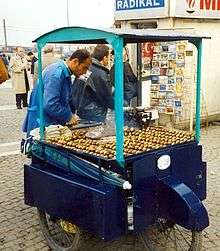Castanea sativa
| Sweet chestnut | |
|---|---|
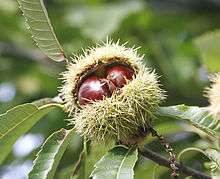 | |
| Sweet chestnut fruit | |
| Scientific classification | |
| Kingdom: | Plantae |
| (unranked): | Angiosperms |
| (unranked): | Eudicots |
| (unranked): | Rosids |
| Order: | Fagales |
| Family: | Fagaceae |
| Genus: | Castanea |
| Species: | C. sativa |
| Binomial name | |
| Castanea sativa | |
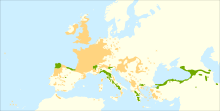 | |
| Distribution map | |
| Nutritional value per 100 g (3.5 oz) | |
|---|---|
| Energy | 891 kJ (213 kcal) |
|
45.54 g | |
| Dietary fiber | 8.1 g |
|
2.26 g | |
| Saturated | 0.425 g |
| Monounsaturated | 0.780 g |
| Polyunsaturated | 0.894 g |
|
2.42 g | |
| Tryptophan | 0.027 g |
| Threonine | 0.086 g |
| Isoleucine | 0.095 g |
| Leucine | 0.143 g |
| Lysine | 0.143 g |
| Methionine | 0.057 g |
| Cystine | 0.077 g |
| Phenylalanine | 0.102 g |
| Tyrosine | 0.067 g |
| Valine | 0.135 g |
| Arginine | 0.173 g |
| Histidine | 0.067 g |
| Alanine | 0.161 g |
| Aspartic acid | 0.417 g |
| Glutamic acid | 0.312 g |
| Glycine | 0.124 g |
| Proline | 0.127 g |
| Serine | 0.121 g |
| Vitamins | Quantity %DV† |
| Vitamin A equiv. |
0% 1 μg |
| Thiamine (B1) |
21% 0.238 mg |
| Riboflavin (B2) |
14% 0.168 mg |
| Niacin (B3) |
8% 1.179 mg |
| Pantothenic acid (B5) |
10% 0.509 mg |
| Vitamin B6 |
29% 0.376 mg |
| Folate (B9) |
16% 62 μg |
| Vitamin B12 |
0% 0.00 μg |
| Vitamin C |
52% 43.0 mg |
| Minerals | Quantity %DV† |
| Calcium |
3% 27 mg |
| Copper |
22% 0.447 mg |
| Iron |
8% 1.01 mg |
| Magnesium |
9% 32 mg |
| Manganese |
45% 0.952 mg |
| Phosphorus |
13% 93 mg |
| Potassium |
11% 518 mg |
| Sodium |
0% 3 mg |
| Zinc |
5% 0.52 mg |
| Other constituents | Quantity |
| Water | 48.65 g |
|
| |
| |
|
†Percentages are roughly approximated using US recommendations for adults. Source: USDA Nutrient Database | |
Castanea sativa, or sweet chestnut, is a species of flowering plant in the family Fagaceae, native to Southern Europe and Asia Minor, and widely cultivated throughout the temperate world. A substantial, long-lived deciduous tree, it produces an edible seed, the chestnut, which has been used in cooking since ancient times.
Names
The tree is commonly called the "chestnut", or "sweet chestnut" to distinguish it from the horse chestnut Aesculus hippocastanum, to which it is only distantly related. Other common names include "Spanish chestnut",[2] "Portuguese chestnut" and "marron" (French for "chestnut"). The Latin sativa means "cultivated by humans".[3] Some selected varieties are smaller and more compact in growth yielding earlier in life with different ripening time: the Marigoule, the Marisol and the Maraval.
Description
C. sativa attains a height of 20–35 m (66–115 ft) with a trunk often 2 m (7 ft) in diameter. The bark often has a net-shaped (retiform) pattern with deep furrows or fissures running spirally in both directions up the trunk. The oblong-lanceolate, boldly toothed leaves are 16–28 cm (6–11 in) long and 5–9 cm (2–4 in) broad.
The flowers of both sexes are borne in 10–20 cm (4–8 in) long, upright catkins, the male flowers in the upper part and female flowers in the lower part. In the northern hemisphere, they appear in late June to July, and by autumn, the female flowers develop into spiny cupules containing 3-7 brownish nuts that are shed during October. The female flowers eventually form a spiky sheath that deters predators from the seed.[4] Some cultivars ('Marron de Lyon', 'Paragon' and some hybrids) produce only one large nut per cupule, rather than the usual two to four nuts of edible, though smaller, size.
The tree requires a mild climate and adequate moisture for good growth and a good nut harvest. Its year-growth (but not the rest of the tree)[5] is sensitive to late spring and early autumn frosts, and is intolerant of lime. Under forest conditions, it will tolerate moderate shade well. It can live to more than 2,000 years of age in natural conditions, see the poetically-named "hundred-horse chestnut" in eastern Sicily for example.
The leaves provide food for some animals, including Lepidoptera such as the case-bearer moth Coleophora anatipennella and rose chafer Macrodactylus subspinosus.
Distribution
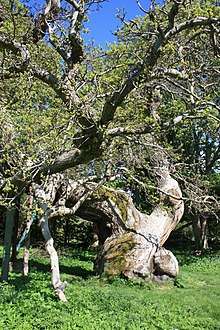
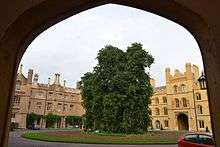
C. Sativa is found across the Mediterranean region, from the Caspian Sea to the Atlantic Ocean. It is thought to have survived in several refuges during the last ice age in southern Europe, northeast Turkey and the Caucasus. It then spread north and west throughout mainland Europe, and is thought to have arrived in Italy from Asia Minor with the Greeks.[6]
The species is widely distributed throughout southern Europe where it covers more than 1700.000 ha. It is often found cultivated in coppices and orchards and more rarely in forest stands.[6]
Uses
The species is widely cultivated for its edible seeds (also called nuts) and for its wood. As early as Roman times, it was introduced into more northerly regions, and later was also cultivated in monastery gardens by monks. Today, centuries-old specimens may be found in Great Britain and the whole of central, western and southern Europe.
The tree was a popular choice for landscaping in England, particularly in the 18th and 19th centuries. C. sativa was probably introduced to the region during the Roman occupation, and many ancient examples are recorded.[4] More recently, the tree has occasionally been planted as a street tree in England, and examples can be seen particularly in the London Boroughs of Islington and Camden.
A tree grown from seed may take 20 years or more before it bears fruits, but a grafted cultivar such as 'Marron de Lyon' or 'Paragon' may start production within five years of being planted. Both cultivars bear fruits with a single large kernel, rather than the usual two to four smaller kernels.[5]
The ornamental cultivar C. sativa 'Albomarginata'[7] has gained the Royal Horticultural Society's Award of Garden Merit.
Sweet chestnut has been listed as one of the 38 substances used to prepare Bach flower remedies,[8] a kind of alternative medicine promoted for its effect on health. However, according to Cancer Research UK, "there is no scientific evidence to prove that flower remedies can control, cure or prevent any type of disease, including cancer".[9]
Food
The raw nuts, though edible, have a skin which is astringent and unpleasant to eat when still moist; after drying for a time the thin skin loses its astringency but is still better removed to reach the white fruit underneath. Cooking dry in an oven or fire normally helps remove this skin. Chestnuts are traditionally roasted in their tough brown husks after removing the spiny cupules in which they grow on the tree, the husks being peeled off and discarded and the hot chestnuts dipped in salt before eating them. Roast chestnuts are traditionally sold in streets, markets and fairs by street vendors with mobile or static braziers.
The skin of raw peeled chestnuts can be relatively easily removed by quickly blanching the nuts after scoring them by a cross slit at the tufted end.[10] Once cooked, chestnuts acquire a sweet flavour and a floury texture similar to the sweet potato. The cooked nuts can be used for stuffing poultry, as a vegetable or in nut roasts. They can also be used in confections, puddings, desserts and cakes. They are used for flour, bread making, a cereal substitute, coffee substitute, a thickener in soups and other cookery uses, as well as for fattening stock. A sugar can be extracted from them.[5] The Corsican variety of polenta (called pulenta) is made with sweet chestnut flour. A local variety of Corsican beer also uses chestnuts. The product is sold as a sweetened paste mixed with vanilla, crème de marrons, sweetened or unsweetened as chestnut purée or purée de marron, and candied chestnuts as marrons glacés.[11] In Switzerland, it is often served as Vermicelles.
Roman soldiers were given chestnut porridge before going into battle.[4]
Leaf infusions are used in respiratory diseases and are a popular remedy for whooping cough.[5] A hair shampoo can be made from infusing leaves and fruit husks.[5]
Wood

This tree responds very well to coppicing, which is still practised in Britain, and produces a good crop of tannin-rich wood every 12 to 30 years, depending on intended use and local growth rate. The tannin renders the young growing wood durable and resistant to outdoor use, thus suitable for posts, fencing or stakes.[12] The wood is of light colour, hard and strong. It is used to make furniture, barrels (sometimes used to age balsamic vinegar), and roof beams notably in southern Europe (for example in houses of the Alpujarra, Spain, in southern France and elsewhere). The timber has a density of 560 kg per cubic meter,[13] and due to its durability in ground contact is often used for external purposes such as fencing.[13] It is also a good fuel, though not favoured for open fires as it tends to spit.[5]
Tannin is found in the following proportions on a 10% moisture basis: bark (6.8%), wood (13.4%), seed husks (10 - 13%). The leaves also contain tannin.[5]
Cultivars
French origin
American origin
- Colossal
- Labor Day
See also
References
- ↑ Miller. Gardeners Dictionary ed. 8 no. 1 (1768). Flora Europaea: Castanea sativa
- ↑ Royal Botanic Garden, Sydney blooming calendar
- ↑ Harrison, Lorraine (2012). RHS Latin for gardeners. United Kingdom: Mitchell Beazley. p. 224. ISBN 9781845337315.
- 1 2 3 Kew Gardens - Rhizotron & Xstrata Treetop Walkway - Castanea sativa
- 1 2 3 4 5 6 7 “Plants For A Future” (PFAF)
- 1 2 Fernández-López, J. & Alía, R. (2003). "Chestnut - Castanea sativa" (PDF). EUFORGEN Technical Guidelines for Genetic Conservation and Use.
- ↑ "RHS Plant Selector - Castanea sativa 'Albomarginata'". Retrieved 26 June 2013.
- ↑ D. S. Vohra (1 June 2004). Bach Flower Remedies: A Comprehensive Study. B. Jain Publishers. p. 3. ISBN 978-81-7021-271-3. Retrieved 2 September 2013.
- ↑ "Flower remedies". Cancer Research UK. 2017-08-30. Retrieved September 2, 2013.
- ↑ An easy way of peeling the pellicle, or pithy skin
- ↑ Lori Alden. 2006 The Cook's Thesaurus. nut pastes
- ↑ Oleg Polunin. Trees and Bushes of Britain and Europe. Ed Paladin, 1973, pp. 51, 188 and 195).
- 1 2 Chestnut. Niche Timbers. Accessed 19-08-2009.
External links
| Wikispecies has information related to Castanea sativa |
![]()
- U.C. Davis, California: Castanea sativa in horticulture
- Plants for a Future database: Castanea sativa
- Castanea sativa - distribution map, genetic conservation units and related resources. European Forest Genetic Resources Programme (EUFORGEN)
.jpg)

